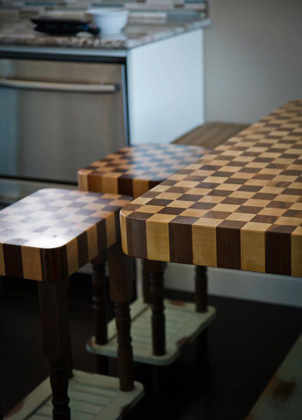Materials
At Canadian Butcher Block Company, we use sustainably harvested hardwoods. The majority of our wood is sourced locally from Ontario, but when a project requires it, we have the expertise and supply network to use wood species from all over the world.
Our most commonly used and recommended woods are:
- Ash
- Native to Ontario, Ash is a very light coloured and straight grained hardwood that is sometimes confused with Oak due to its similarities when finished. Ash has recently become threatened in certain areas due to the Emerald Ash Borer, a beetle that is native to Asia. The majority of Ash processed in Ontario is now exported because local demand is currently low. The heart wood of the Ash tree is quite dark and offers a nice variation in colour. Additionally, when our torching process is used on the wood, the variation in growth ring density produces a unique offering.
- Black Cherry
- Native to Southern Ontario, Black Cherry was once the wood of choice for the kitchen cabinet industry in Canada. Over the past decade other types of wood have gained popularity and this has caused the price of Black Cherry to drop significantly, thus making it a very competitive option as a wood countertop material. It has a relatively straight grain structure, and reddish colour. Cherry will darken dramatically over time from UV exposure and it can be a challenge to design around its red hues. When integrated successfully into the design scheme, it makes for a dramatic addition to a home's décor.
- Hickory
- Native to North America, Hickory is valued for its strength. Its wood is very dense and durable with straight grain and yellowish to light-brown colouring. Hickory has a reputation in the woodworking industry as a product that is difficult to work with. For this reason, it has lost some of its popularity, but we feel its natural beauty as a countertop material is worth the extra attention required to work with it. The live edge portion of Hickory is very organic looking with extreme shape and colour variation.
- Sugar / Rock Maple
- Native to Southern Ontario, the wood of the Sugar Maple is hard and dense. Its hardness, straight grain and whitish yellow/gold colouring makes it a frequent choice for butcher blocks. The heart wood of Maple can be quite brown which adds a nice variation otherwise missing in the sap wood. In recent years the cost of Maple has started to climb, yet it still remains one of the most economical.
- White Oak
- Native to Ontario, White Oak is a long-lived species with tight, straight grain. It is valued for its hardness, strength and resistance to splintering. White Oak is an excellent choice for butcher blocks due to its unique closed cell structure that makes it water and rot resistant. White Oak contains a moderate amount of tannic acid, making it an ideal candidate for our ebonizing process.
- Sapele
- An exotic hardwood native to Africa with a very straight grain and colouring similar to Mahogany. Also known as African Mahogany, it has a rich reddish hue that darkens with UV exposure. Sapele is a very dense and dimensionally stable option for our climate. Sapele contains a large amount of tannic acid, making it ideal for ebonizing as our process turns it virtually black while still retaining a faint grain definition.
- Walnut
- There are over 20 species of walnut from Europe, Asia, North America and South America. The Walnut most commonly used for table tops, countertops and butcher blocks is locally sourced Black Walnut. Black Walnut is an extremely durable, and strong hardwood, valued for its rich brown colouring. Even though the cost of Walnut has increased, it continues to be the most popular choice of material for our products. The live edge portion of Walnut contains a dramatic colour change from the dark brown heart wood to a very light tan. Due to demand, grading methods for Walnut are unique from all other woods.
This list, though not exhaustive, contains the best options for materials that we feel are the most economical, durable, available and beautiful in their own right. We offer certain treatments to these woods that can alter their appearance slightly or dramatically, while not compromising on food safety. For further details on these treatments, please see our FINISHES page.






